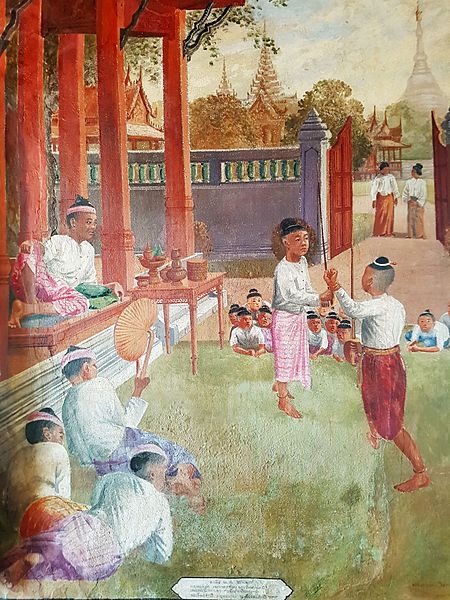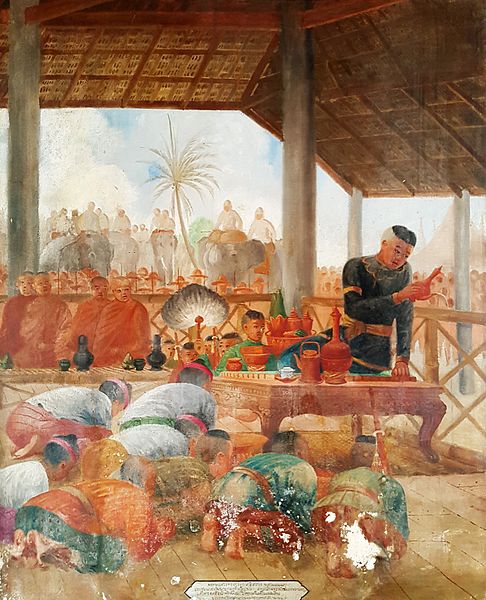
A Biography of King Naresuan the Great by Prince Damrong Rajanubhab is a worthy part of the Thammasat University Libraries collection. Translated and edited by Kennon Breazeale, an Affiliate Faculty Member, Center for Southeast Asian Studies, University of Hawaii, the book makes available in English historical research by HRH Prince Tisavarakumarn, the Prince Damrong Rajanubhab (1862–1943), son of HM King Mongkut and half-brother to HM King Chulalongkorn (Rama V). In addition to his other accomplishments, HRH Prince Damrong is credited with founding the Kingdom’s modern educational system and provincial administration. This edition of his book was produced under the auspices of the Toyota Thailand Foundation and the Foundation for the Promotion of Social Sciences and Humanities Textbooks (SSHT) Project. The Secretary of the SSHT Foundation, located on Arun-amarin Road in Bangkok, is the noted historian Ajarn Charnvit Kasetsiri, former rector of TU and dean of the Faculty of Liberal Arts, among his many other services to the university. In 1976, the SSHT Foundation’s chair, Ajarn Puey Ungphakorn, wrote that when the SSHT Project was first launched ten years before, it was motivated by personal passion for the mission of educational institutions. With matching funds from the Rockefeller Foundation, the project’s goal was to encourage good quality textbooks in Thailand, especially in the social sciences and humanities. Dr. Puey believed that university educational standards
may help bolster the creative intelligence, initiative, and correct understanding with regards to the economy, society, culture, and politics as a whole.
The idea was to gather writings by scholars both within and outside institutions of higher learning, to make high-quality quality knowledge equally available for all teachers, students and those interested in pursuing academic careers. Editions, transcriptions, compilations, and translations of books in the fields of geography, history, economics, political science, sociology, anthropology, philosophy, psychology, and languages and literature were all presented.
All Thais know the story of HM Naresuan, ruler of the Ayutthaya Kingdom and overlord of Lan Na. In many battles, he defended the independence of the Kingdom of Ayutthaya against Burmese forces. His heroic exploits, including such vivid episodes as a duel atop elephants, still inspire schoolchildren and others in the Kingdom today. Although he died at the relatively young age of 49, King Naresuan remains a key figure in the history of his country, celebrated in a series of films and also in the name of Naresuan University in Phitsanulok, northern Thailand. King Naresuan has been commemorated with statue, images on Thai baht banknotes, HTMS Naresuan, Royal Thai Navy frigate, and Naresuan Dam, one of the two largest dams in Phitsanulok Province. There have been animated feature films about Khan Kluay, the king’s war elephant, and the elephant’s children. Students who enjoy fantasy massively multiplayer online role-playing games (MMORPG) may have noticed one entitled King Naresuan Online. Yet another computer-based tribute is the Civilization V — PC game with a unit named Naresuan’s Elephant in honor of the king’s elephant armies. It is fitting that such a culturally resonant historical figure should be carefully studied by HRH Prince Damrong Rajanubhab, a self-taught historian. A productive writer, HRH Prince Damrong’s works have been studied in another book by Professor Breazeale in the collection of the TU Libraries, also sponsored by the Toyota Thailand Foundation PSSH Foundation Humanities Textbooks Project, The Writings of Prince Damrong Rajanubhab: A Chronology with Annotations. This reminds us that part of the special interest of A Biography of King Naresuan the Great is that it was written by a Prince who also played a significant role in the Kingdom’s history. A 2012 article from Thailand Tatler noted that
to mark the 150th anniversary of the birth of Prince Ditsawarakuman Damrong Rajanubhab, which falls on June 21, his life and works are to be celebrated in a series of events organised by the Ministry of Education and the extended Diskul family, his descendants. Among his many achievements, he is known as the father of Thai history and archaeology and the founder of Thailand’s modern educational and health systems, as well as being credited with the modernisation of the provincial administration. Prince Damrong is also remembered as one of Thailand’s most influential intellectuals, leaving behind a great literary legacy. Marking the centenary of his birth in 1962, and in recognition of his vast contribution to Thai society, he became the first Thai to be awarded the UNESCO World Outstanding Personality title.

The article informed readers that the Prince wrote books on Thai literature, culture and the arts. Two of his grandsons were interviewed for the article: Mom Rajawongse (MR) Disnadda, chairman of the Prince Damrong Foundation and secretary-general to the Mae Fah Luang Foundation Under Royal Patronage; and Mom Rajawongse Damrongdej Diskul, also a member of the Prince Damrong Foundation. MR Disnadda recalled early childhood visits to his grandfather at Varadis Palace, designed and built in 1911 by the German architect Karl Döhring. In 1996 the building on Larn Luang Road was renovated and converted into a museum and library. MR Disnadda explained:
I remember that in the evenings my grandfather would sit on the teak veranda inside a contraption that looked like a wooden cage covered in mosquito netting. In the day I would crawl about on the floor, but because I couldn’t really crawl my grandfather named me Chai Tad, Thai for ‘pushing oneself along.’… I remember lots of people coming by and talking to him. I didn’t understand what they were saying but I knew he was important because everyone treated him with such respect and courtesy. Even as a child I understood. He was a kind, soft-spoken person whom people looked up to.
In 2001, the Prince’s family launched a project to digitize the collection of personal writings and books in the Prince Damrong Rachanupab Library, Varadis Palace. Apart from photographs and Prince Damrong’s writings on Thai history, literature and culture, the collection includes around 7,000 biographies, histories, and political studies in English and Thai. Using these and other sources, the Prince arrived at his historical conclusions; like all history books, details in A Biography of King Naresuan the Great has stimulated some debate and disagreements from professional historians, but its overall historical impact and value are not in doubt. His curiosity and appetite for knowledge are shown in a text translated in 2013 for the Journal of the Siam Society, Prince Damrong Rajanubhab’s Conversation with Robbers. Translated by Matt Reeder, a graduate student at Cornell University, and Dr. Chalermchai Wongrak of the Western Languages and Literature Department of Ubon Ratchathani University, the text reveals an interrogation from 1903. A gang of buffalo thieves were put on trial, and Prince Damrong, then Minister of the Interior, published their testimony to help educate policemen and other readers about the law-breakers’ techniques and motivations. Edited and rewritten for literary effect by the Prince and originally published in a cremation volume, the result remains of interest to social scientists as well as general readers.

(All images courtesy of Wikimedia Commons).
